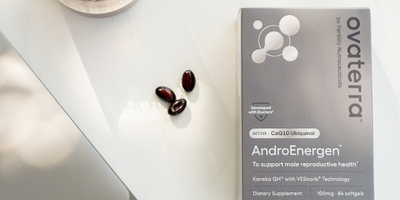Semen analysis is a routine part of male fertility assessment. In a semen analysis, an andrologist evaluates multiple aspects of a semen sample, including the quality of the sperm, the seminal fluid and the compounds found in the semen. These factors all affect the likelihood for a man to establish a pregnancy. Let’s take a deep dive into what semen analysis evaluates, if semen analysis can be done at home reliably and how you can improve the results.
Who needs a semen analysis?
Typically, semen analysis is performed for men who want to know if their reproductive health is in good shape. When a couple consults a fertility doctor, semen analysis is often included in the first assessment. It’s also done to confirm that a vasectomy was successful.
How is a semen analysis performed?
To perform a semen analysis, you will be asked to provide a semen sample by ejaculating. In many cases, your doctor will ask you to refrain from ejaculating for 2-5 days before the collection day, but no more than 7 days. This is to ensure that the sample is just right in terms of sperm count and their liveliness. Your sample is then analyzed by an andrologist in the lab.
What factors does a semen analysis look at?
Semen analysis looks at multiple aspects of sperm health. Here are the key items on your semen analysis result:
- pH of semen: Semen should be somewhere between 7.2 and 8.0. A healthy pH of semen has been shown to correlate with sperm count, its ability to move and its fertilization potential.
- Sperm concentration: Sperm concentration is calculated from the sperm count in the sample and semen volume of the sample. There is a relatively wide range of normal sperm concentration, between 15 million/mL and 200 million/mL. While still within the normal range, when the sperm concentration is below 50 million/mL, you may find it challenging to establish a pregnancy. (This is why the recent finding that the global mean sperm concentration has dropped below this level is alarming.)
- Sperm morphology: Morphology refers to the structural integrity of the sperm, which is necessary to swim and fertilize an egg. The andrologist observes the sperm’s head, midsection and tail under the microscope to see how many of the sperm conform to what healthy sperm should look like. Surprisingly, it’s normal to have a majority of your sperm be abnormal-looking. Under the few prevailing criteria, it’s considered normal to have just 4-14% of the sperm with perfect morphology.
- Sperm motility: Sperm needs to be able to move through the female reproductive tract to meet and fertilize the egg. Motility refers to the sperm’s ability to do just that. A related factor, the ability to move in a straight line (called progressive motility), is also important. Ideally, more than half of the sperm should be actively moving, but above 40% is considered normal, up to 81%. For progressive motility, 32-75% is considered normal.
- Time to liquefaction: Semen is thick when ejaculated, but needs to become watery soon after to allow sperm to move freely through the cervix, the uterus and the fallopian tube. Time to liquefaction measures how long it takes for semen to achieve this watery consistency, and should be about 20 minutes. On the female side, during the fertile window, the cervical fluid becomes watery, too, in order to help sperm swim ahead.
- White blood cells: When there are white blood cells in the semen, that can be a sign of infection or inflammation, which can impact sperm health.
Can semen analysis tell me if I’m fertile or not?
Semen analysis can pick up problems around sperm health, and for male reproductive health, sperm health is the biggest factor. However, having a normal or abnormal semen analysis result doesn’t automatically mean that you can or cannot have children. Other male factors are involved in conception that semen analysis doesn’t assess (erectile dysfunction is an example).
The good news is that a vast majority of men with abnormal semen analysis results can still have biological children with a doctor’s help.
Are there at-home options for semen analysis?
Although fertility centers and labs that perform semen analysis try to provide a private, relatively comfortable space for men to produce a semen sample, that’s not something most people look forward to. (Then again… that’s not much compared to what their female partners go through.) Instead, there are some at-home options for semen analysis.
Depending on the facility and how close you are to it, you may be able to collect your semen sample at home and drop it off for analysis. With at-home collection, there are several things to keep in mind:
- It’s critical that the sample arrives at the lab in less than one hour.
- The sample should be kept at room temperature. Don’t be tempted to put it in the fridge.
- When producing a sperm sample, don’t use lubricants. They can affect sperm motility, semen pH and other sperm analysis results.
Are at-home sperm test the same as semen analysis?
There are also at-home semen analysis kits that you can purchase online. With some of these at-home sperm tests, you read the results yourself; with others, you send your sample to a lab to receive the results later.
Quality and thoroughness of at-home semen analyses vary. Some tests only look at one or two aspects of sperm health, while others are more comprehensive. Whether the sample is analyzed by a professional andrologist, by an algorithm-enabled app or by the tester himself also can make a difference in reliability of the results.
In most cases, at-home sperm tests are a convenient, private way to get a sense of your sperm health, but they aren’t the same as semen analysis. At-home semen analysis can be helpful for couples who are just starting out, but most urologists and fertility doctors consider at-home tests an imperfect alternative to a semen analysis done at a fertility center or a clinical laboratory.
Is it possible to improve semen analysis results?
To improve semen analysis results, you need to take steps to support the health of your sperm. There are several lifestyle factors within your control that doctors know can be supportive:
- Eat a healthy diet with plenty of antioxidants: Mediterranean diet is considered one of the best “fertility diets” for both men and women. Aim to incorporate foods rich in antioxidants like Vitamin C, Vitamin E, Selenium and Zinc, as well as omega-3 healthy fats (DHA and EPA) to support sperm health.
- Consider supplements: Dietary supplements designed to support sperm health can bridge the nutritional gap you may still have with a healthy diet. Coenzyme-Q10 (CoQ10, an antioxidant and a facilitator of cellular energy production) and male prenatal vitamins are two supplements that could support sperm health from the ground up.
- Reduce exposure to environmental toxins: Chemicals like BPA and PFAS have been known to negatively impact sperm count, morphology and other aspects of male reproductive health. (They also negatively impact women’s reproductive health.) Take these relatively simple steps to reduce your exposure to BPA and PFAS.
- Avoid exposure to radiation: This is typically a concern for men (and women) who are exposed to radiation on the job, but some studies have suggested other, everyday sources of radiation may be a concern.
- Try to get enough quality sleep: Sleep is a forgotten key to reproductive health. Scientists have known for decades that shift workers, whose circadian rhythms can be disrupted, have a harder time establishing a pregnancy. Getting 7+ hours of quality sleep each night has also been linked to sperm health.
- Limit alcohol consumption: Heavy drinking has been linked to multiple problems with sperm health. If you drink more than moderately, cutting back to 2 drinks or less per day is a good idea, at least while you are trying for a baby.
- Quit smoking: Everyone knows smoking is bad for your health, and that’s true for sperm health, too.
Taking these steps can help you support sperm health, a key factor in male reproductive health assessed in semen analyses. Please reach out if you have any questions about semen analyses or sperm health. We are with you.
Ovaterra provides reproductive health resources for general, educational purposes only. This content is not intended to replace medical advice from a qualified healthcare professional. Similarly, when making your financial decisions, please consult qualified financial professionals who can make individual recommendations.









